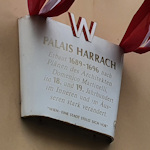
In the late 17th century, Count Harrach bought up a burnt-out ruin on prime Viennese real estate just opposite the venerable Schottenkirche church. A few barrels of bricks later and the city had gained another example of classic Baroque architecture: Palais Harrach.
- Town palace completed around 1696
- Still dominates one side of the Freyung square
- See also:
The Harrachpalais

(View from the Freyung square)
Construction on this Baroque townhouse finished in 1696, the previous building having fallen victim to a badly-timed fire in 1683. Badly-timed because the ashes had not even cooled properly before a horde of Ottomans complicated matters by beginning a siege of the city.
The owner of the new building was one Ferdinand Bonaventura I. von Harrach (hence the palais name).
Count Harrach didn’t get to enjoy his new home initially, being busy in Madrid trying to regulate the Spanish succession for the Austrian Habsburgs.
The count eventually moved into his Vienna residence in 1698 to lead, for example, Emperor Leopold I’s foreign policy unit (which I’m sure had a longer name back then).

(The Schottenkirche church and Palais Harrach; drawn by Salomon Kleiner, engraved by Johann August Corvinus, and published by Johann Andreas d. Ä. Pfeffel, 1725; Wien Museum Inv.-Nr. 105765/48; excerpt reproduced with permission under the terms of the CC0 licence)
Architects involved in constructing Palais Harrach included:
- Christian Alexander Oedtl, who also worked, for example, on the nearby Palais Schönborn
- Domenico Martinelli, who also worked, for example, on the nearby Stadtpalais still owned by the princely family of Liechtenstein. (At the time of writing, the suitably-named Trattoria Martinelli occupied premises in Palais Harrach)
The building extends back to Herrengasse and surrounds a large inner courtyard. Palais Harrach even had its own little garden, echoes of which remain in the tiny park to the north of the building (now an entrance to an underground car park).
Rebuilding work in the middle of the 19th century transformed the look of the place, and the cream of Viennese and European society once climbed the staircases for which the palais enjoys particular fame. The last crown prince of the German Empire visited in 1901, for example.

(Federal offices can be found within)
Unfortunately, the location took a lot of damage during WWII. A newspaper of the time (the Neues Wiener Tagblatt) described Palais Harrach as one of the most valuable historical buildings in the city and railed against the damage caused by the “terror attacks of the Americans” (rather biased reporting there).
Subsequent post-war restoration work seemed to return much of the building to its original Baroque design and what we can see today.
In recent decades, Palais Harrach has served less aristocratic purposes: film set and fashion show venue, art gallery, exhibition hall, and medical information centre, to name a few.
As well as the Trattoria mentioned above, occupants at the time of writing include an upmarket interior designer, business consultants, and offices of the Federal Ministry for Digital and Economic Affairs.
How to get to Palais Harrach
Just follow the tips for getting to the Freyung (at the bottom of that article).
The palais dominates the south side of the square, the first of three palais buildings leading down toward the very centre of town. The next two are Palais Ferstel and Palais Hardegg.
Address: Freyung 3, 1010 Vienna